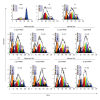Toll-Like Receptor 4 Signaling in High Mobility Group Box-1 Protein 1 Mediated the Suppression of Regulatory T-Cells
- PMID: 28096525
- PMCID: PMC5267620
- DOI: 10.12659/msm.902081
Toll-Like Receptor 4 Signaling in High Mobility Group Box-1 Protein 1 Mediated the Suppression of Regulatory T-Cells
Abstract
BACKGROUND Treg cells play a central role in the suppression of immune response, and their suppressive capacity can be modulated by toll-like receptor (TLR) ligands. However, the detailed pathway of TLR ligand modulation is still unknown. The present study aimed to evaluate the effect of the high mobility group box-1 protein 1 (HMGB1) and lipopolysaccharide (LPS) on Treg cells through TLR4 signaling. MATERIAL AND METHODS Treg cells were purified from healthy human peripheral blood mononuclear cells (PBMCs) by magnetic-bead activity cell sorting (MACS), blocked by anti-TLR4 monoclonal antibody, and then incubated with different concentration of LPS or HMGB1. The level of gene expression of IL-1β, IL-10, IFN-γ, and TGF-β were detected using quantitative real-time polymerase chain reaction (qPCR) and enzyme-linked immunosorbent assay (ELISA), and the proliferation of Treg cells after treating by LPS and HMGB1 was analyzed by flow cytometry. The NF-κB expression in Treg cells was examined by Western blotting. RESULTS LPS treated CD4 CD25 Treg cells directly increased the expression of IL-1b and IL-10 and decreased the expression of IFN-γ and TGF-β. However, HMGB1 treatment resulted in a marked decreased expression of IL-1β, IL-10, IFN-γ, and TGF-β. The proliferation of CD4+ T cells was significantly inhibited by Treg cells in the LPS treatment group, but weaken in the HMGB1 treatment group. These data suggest that HMGB1 and LPS stimulation could downregulate the expression NF-κB p65 in cytoplasmic proteins and increase the expression in nuclear proteins, thus leading to modulation of IL-1β, IL-10, IFN-γ, and TGF-β expression; moreover, the suppressive function of Treg cells could be regulated by TLR4. CONCLUSIONS TLR4 signaling in HMGB1 mediated the suppressive function of Treg cells through the activation of the NF-κB pathway.
Conflict of interest statement
The authors declare that there is no conflict of interest regarding the publication of this paper.
Figures






References
-
- Lewkowicz P, Lewkowicz N, Sasiak A, Tchorzewski H. Lipopolysaccharide-activated CD4+CD25+ T regulatory cells inhibit neutrophil function and promote their apoptosis and death. J Immunol. 2006;177:7155–63. - PubMed
-
- Sutmuller RP, Morgan ME, Netea MG, et al. Toll-like receptors on regulatory T cells: expanding immune regulation. Trends Immunol. 2006;27:387–93. - PubMed
-
- Eiro N, Altadill A, Juarez LM, et al. Toll-like receptors 3, 4 and 9 in hepatocellular carcinoma: Relationship with clinicopathological characteristics and prognosis. Hepatol Res. 2014;44:769–78. - PubMed
-
- Kawai T, Akira S. The role of pattern-recognition receptors in innate immunity: update on Toll-like receptors. Nat Immunol. 2010;11:373–84. - PubMed
MeSH terms
Substances
LinkOut - more resources
Full Text Sources
Research Materials
Miscellaneous

